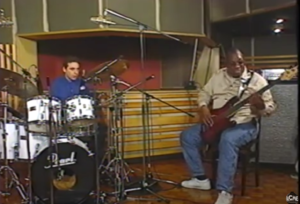ベースをビートよりも前、後ろ、またはビートに合わせて演奏することについて(By Orlando le Fleming)
Orlando le Fleming氏が語る「ベースをビートよりも前、後ろ、またはビートに合わせて演奏することについて」を翻訳しました。
とても興味深い内容です。
内容に誤りがございましたらご指摘いただけるとありがたいです。
翻訳文
Hi everyone, so today I'm going to try and tackle the elusive mysterious subject of playing ahead of a beat, playing on the beat, playing behind the beat. Um, what I think about it, it's a big subject, and um, there are many aspects, so um, the first thing I tell all my students, and sorry if you've heard this before, but um, is you have to have a beat of your own in the first place to play ahead of or behind or on. If you don't have your own beats that you can supply yourself without the help of drums or a machine or a metronome, you can't push it, right? So just work on your own groove. Groove, make that whole dance hall dance with your quarter notes, you know? And that obviously takes all the things that we talk about: the strong consistent sound, open strings exercises, all that stuff, left hand strength, and knowing some lines that fall under the fingers, and playing the skip notes that sound good and don't, you know, sound like you're falling up the steps.
皆さん、こんにちは。今日は、難解で神秘的なテーマである「ビートの先行演奏、ビートに乗せた演奏、ビートの遅れ演奏」について取り組んでみようと思います。私が考えるに、これは大きなテーマであり、多くの側面がありますので、まず最初に私がすべての生徒に伝えることは、自分自身のビートをまず持っていなければ、先行演奏や遅れ演奏、またはビートに乗せた演奏をすることはできないということです。ドラムや機械、またはメトロノームの助けなしで自分自身に供給できるビートを持たなければ、それを推進することはできませんよね?ですから、まずは自分自身のグルーヴに取り組んでください。グルーヴによって、クオーターノートでダンスホール全体を踊らせるのです。これには、私たちが話すすべての要素が必要です:強く一貫した音、開放弦の練習、左手の強さ、指に合うフレーズを知ること、そして良い音を出すスキップノートの演奏と、階段から転げ落ちているような音ではなく。
Um, so that's what I say first, just work on holding a tempo, having a groove that people can hear. And then when you do have that, your life becomes so much easier because drummers and the musicians can just hear it and identify with it and hook up with it. And maybe they adjust their tempo a bit just to hook up with it, or you find a happy medium. You might not be playing exactly in the same part of the beat, but if you're both strong, you're kind of going like this or you can find where you fit with that beat. Uh, and that might take some time with certain drummers, but you know, if it's a good drummer, then it should be okay. But you've got to take responsibility for that yourselves as bass players and not rely on the drums to be that metronome, for instance, like when you practice with a metronome, the metronome is going to stay there, right? It's a machine. You could sort of play all around it, but when you're playing with human beings, it's slightly different because they're human and they're not like a machine. And it's a two-way thing that's just as much your responsibility as the drummer's, so just bear that in mind. Get that strong pocket, set yourself to the highest standard.
まず最初に言いたいのは、テンポを保ち、人々が聴けるようなグルーヴに取り組むことです。それができれば、あなたの人生はずっと楽になるでしょう。ドラマーや他のミュージシャンはそれを聞いて共感し、それに合わせて演奏することができます。おそらく彼らは自分のテンポを少し調整してそれに合わせるか、ハッピーミディアムを見つけるでしょう。あなたがビートのまったく同じ部分で演奏していなくても、両者が強ければ、お互いがうまくフィットすることができます。特定のドラマーとの相性には時間がかかるかもしれませんが、良いドラマーであれば問題ありません。ただし、ベーシストとして、それについて自分自身で責任を持つ必要があります。ドラムがメトロノームの役割を果たすことに頼らず、自分たち自身でメトロノームのようになる必要があります。たとえば、メトロノームと一緒に練習する場合、メトロノームはそのままでしょう?それは機械です。あなたはメトロノームの周りで演奏することができますが、人間と一緒に演奏する場合は少し違います。なぜなら、彼らは人間であり、機械のようではないからです。これは、ドラマーと同じくらいあなたの責任である、相互の関係です。それを念頭に置いてください。しっかりとしたグルーヴを持ち、最高の基準を自分に設定してください。
Now, as far as actually playing ahead of the beat, I feel like with me, uh, certain tempos, certain when I get together with certain drummers and certain tempos, I can sometimes be ahead of the beat. Other tempos, I'm not so ahead of the beat, it depends. But I was a huge Ray Brown fan, I still am, and when I was younger, what got me into his world of where he places his beat was the obvious thing of just transcribing his walking bass lines and playing along exactly, trying to mimic where he placed that note exactly. I remember doing that with some of Oscar Peterson Trio records and a few choruses of "Sometimes I'm Happy" from "Live in Chicago." I played along with that, and it's a great bass solo too, that's another thing. And then, "Days of Wine and Roses" when we get requests, a couple of choruses when he goes into walking, that sort of thing. So that really helped me embody that world.
実際にビートの先行演奏をする場合、私自身は、特定のテンポや特定のドラマーとの共演時には、時々ビートの先行演奏をします。他のテンポではあまり先行演奏しないこともあります。状況によりますね。私はRay Brownの大ファンであり、今でも彼の音楽を愛しています。若かった頃、彼がビートを置く場所に入り込むきっかけとなったのは、彼のウォーキングベースのラインをトランスクライブし、彼がノートを置く具体的な位置を模倣しようとしたことでした。Oscar Peterson Trioのレコードや、"Live in Chicago"の中の"Sometimse I'm Happy"のコーラスを何曲か、それに合わせて演奏しました。それは素晴らしいベースソロでもありますし、それもまた重要な要素です。そして、「Days of Wine and Roses」では、リクエストがあった場合には、ウォーキングベースのパートに入る場面を数コーラス演奏しました。そのような経験を通じて、私はその世界に入り込むことができました。
Now, if you're not playing along to records, if you're not transcribing those great bass players, and you're just using drum machines or, you know, whatever it is like a real book play-alongs and stuff, you're not going to embody that feel or that beat because those are machines. You need to play along with the real thing and feel the humans and get inside their world. So that, me doing that with Ray Brown, and I did it with some, you know, Bob Hurst and those later things too, and that helped me just get inside playing in that way. And it happened to be pushy, a lot of that music, just because I like that.
もしレコードに合わせて演奏せず、偉大なベーシストのトランスクライブをしないで、ドラムマシンやリアルブックの伴奏などを使っているだけなら、あなたはその感覚やビートを身につけることはできません。それらは機械です。本物の音楽に合わせて演奏し、人々を感じ、彼らの世界に入り込む必要があります。だからこそ、私はRay Brownと一緒に演奏することをしてきましたし、後にはBob Hurstなど他のミュージシャンとも共演しました。それによって、その演奏方法に入り込むことができました。私はそのような演奏スタイルが好きだったので、演奏は力強くなりました。
Now, there's so… that's how you do it. You have to do, you have to listen to it and absorb yourself. You can't jump ahead and do that. Um, so, um, that, rather than sort of sitting and analyzing it, you know, with a metronome, working on, you've got to, and, you know, just get the feel of the bass players who did it. Now, it's a huge subject, and I'm just touching, you know, the surface here, but also tempos really matter. If you're only playing like three or four different swing tempos because the scene that you play in doesn't really deal with other tempos, or you're just not concentrating on that, everything's medium swing or fast or better, then that's not going to help too because the tempo is really important. And a lot of the times, I think that playing ahead of the beat gets confused with actually just hearing something just a few clicks faster, which has a bit more of a vibe or even 10 BPM faster, something… difference between 160 and 170, there is a big feeling there, but that might not be felt. So that's another problem.
では、そのやり方ですね。あなたはそれを行う必要があります。飛び越してそれを行うことはできません。それを聴いて自分自身を浸す必要があります。メトロノームで座って分析するよりも、それを行ったベーシストの感覚をつかむ必要があります。これは広範なテーマであり、ここでは表面的な部分に触れているだけですが、テンポも非常に重要です。もしプレイするシーンが他のテンポに対応していないか、あるいはそれに集中していない場合、中くらいのスウィングや速いテンポばかり演奏していては助けにはなりません。テンポは本当に重要です。また、ビートの先行演奏は、実際にはわずかに速いものを聴いているだけで、それがビートよりも少し速くなることが混同されることがよくあります。例えば160と170の違いは大きな感覚の違いがありますが、それが感じられないかもしれません。これも別の問題です。
And I feel like, um, you know, maybe you can alleviate that maybe by, you know, practicing time and then just adjusting, you know, a few clicks higher, a few clicks slower with the metronome or seeing how that feels. But also just playing along to records, having a playlist of different drummers and trying to find similar tempo areas and just see how it feels and playing along to that, you know? Um, um, so yeah, I mean, it's a big subject. Um, I know I'm talking a lot of stuff here, so that's the basis of playing ahead, playing behind. Now, you've got to really analyze.
そして、もしかしたら、時間を練習してから、メトロノームを使ってわずかに速めたり遅めたりして、それがどのように感じるかを調整することで、それを軽減できるかもしれません。また、レコードに合わせて演奏したり、さまざまなドラマーのプレイリストを持って、似たようなテンポの領域を見つけて、それに合わせて演奏してみることも良いでしょう。そうすれば、どのように感じるかがわかります。このように、大きなテーマです。ここでたくさんのことを話していることはわかっていますが、それが先行演奏や遅れた演奏の基本です。そして、それを本当に分析する必要があります。
I know one of you wrote in and asked for a playlist, and I'm going to think about it, my… you know, a playlist of examples of bass players playing ahead of the beat in different rhythm sections. But obviously, there's this Ray Brown and Egg Thigpen, and there's a great video that, um, again, one of you mentioned to me of Christian McBride talking with Greg Hutchinson on an open studio lesson on YouTube, and they're talking about how Greg Hutchinson, a great drummer, had to hold Ray Brown back, and he found a spot because Ray was really ahead, so he sat back, and how that relationship between those two great musicians sort of worked. So check out that video, but check out all those great pairings: Paul Chambers, Philly Joe, the different tempos. Sometimes it feels relaxed and it feels laid back, and it sits there nicely. You know, Sam Jones, Lewis Hayes, um, Paul Chambers and Jimmy Cobb, all of them. Ray Brown, obviously, I've mentioned before, but you know, Ron Carter and Tony Williams, would stick with the earlier ones first just because the time is perfect.
私は、皆さんの中の一人がプレイリストをリクエストされたことを知っています。私は考えてみます。ベースプレイヤーがビートよりも前に演奏する様子を、異なるリズムセクションでの例を含めたプレイリストにしようと思います。しかし、明らかに、Ray BrownとEd Thigpenがいます。また、ある方から教えていただいた素晴らしいビデオがあります。それはYouTubeのOpen Studioのレッスンで、Christian McBrideがGreg Hutchinsonと話しているもの(多分これ)で、彼らがRay Brownをどのように引き止めたか、Rayが本当に前に出ていたのでGregが後ろに下がる位置を見つけた方法について話しています。その2人の素晴らしいミュージシャンの関係がどのように機能していたかを確認してください。そのビデオをチェックしてみてください。そして、Paul ChambersとPhilly Joe、さまざまなテンポの素晴らしいコンビネーションもチェックしてください。時にはリラックスしてくつろいだ感じで、うまく配置されています。Sam JonesとLewis Hayes、Paul ChambersとJimmy Cobb、そしてもちろんRay Brownも前に言及しましたが、最初は以前のものに焦点を当てる方が良いでしょう。なぜなら、彼らのタイミングは完璧だからです。
Um, another record I used to love to play along with was "Soul Station" by Hank Mobley, with Art Blakey and Paul Chambers. So just understand the feeling and try and transcribe a couple of choruses of each of those pairings of um, drummers and bass players and try and envelop their world, you know? Get into their world. Um, so yeah, that's how I feel about that. Um, and there's probably stuff I'm missing out, but please, um, you know, I'm interested in your contributions if you have any, um, sort of ideas, uh, about this too. All right.
あと、私が演奏に合わせて楽しんでいた別のレコードは、Hank Mobleyの「Soul Station」で、Art BlakeyとPaul Chambersとの共演です。だから、感覚を理解し、各ドラマーとベーシストのコンビネーションの数コーラスをトランスクライブして、彼らの世界に没頭してみてください。彼らの世界に入り込んでください。そうですね、それが私の考えです。もちろん、私が見落としていることもあるかもしれませんが、もし何かアイデアや貢献があれば、どうぞお知らせください。私はそれに興味を持っています。それでは。
END

